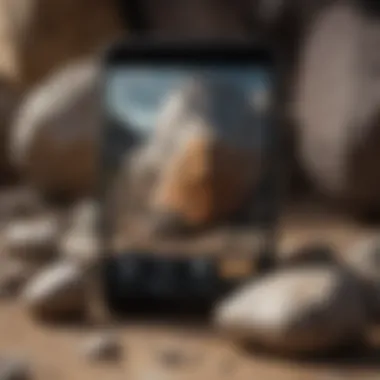Discover the Best Rock Identification Apps Today


Intro
In recent years, the rise of technology has transformed various hobbies, including rock and fossil collection. Collectors now have tools that facilitate identification and enhance their understanding of geology. This shift towards digital solutions has introduced several rock identification apps on the market. Their features and usability can vary significantly, and it is crucial for both amateurs and seasoned enthusiasts to navigate these options effectively.
This article will explore the leading rock identification apps available today, delving into their attributes, strengths, and limitations. From user-friendly interfaces to sophisticated databases, these apps cater to a wide range of users. Whether a novice exploring the basics of geology or an expert seeking detailed information, there's an app that can complement their pursuit. By the end of this discussion, readers will be equipped to make informed choices tailored to their specific rock identification needs.
Foreword to Rock Identification Apps
In an era where technology permeates every aspect of our lives, rock identification apps emerge as pivotal tools for both budding enthusiasts and seasoned geologists alike. These applications not only simplify the identification process but also enhance the overall experience of studying geological specimens.
Understanding the function of rock identification apps is crucial. They offer users a convenient way to access extensive databases of rocks and minerals. Most apps use images, descriptions, and diagnostic tools that allow for swift identification. This immediacy aligns well with the increasingly dynamic lifestyle of today's collectors who often seek information on-the-go.
Beyond mere identification, these applications serve educational purposes. They can help users learn about geological formations, mineral compositions, and the processes that shape our planet's crust. By utilizing these apps, individuals can better appreciate the complexities behind the stones they encounter.
The integration of technology into geology also raises some considerations. While these tools can significantly aid in learning, users must discern between app accuracy and conventional methods of identification. Some rocks may require more detailed analysis than an app can provide. Therefore, they should be seen as complementary to traditional fieldwork and study rather than a complete replacement.
In summary, the significance of rock identification apps is multifaceted. They not only facilitate efficient identification but also foster a deeper understanding of geology. By leveraging these tools, users can elevate their collecting experiences, making rock identification an engaging and informative hobby.
The Importance of Rock Identification
Rock identification is a fundamental aspect of geology that serves multiple purposes. It bridges the gap between amateur enthusiasts and seasoned geologists. Knowing how to identify various rocks and minerals not only enhances one's collection but also fosters a deeper appreciation for the Earth's natural history. This knowledge can transform a casual interest into a serious hobby or educational pursuit.
Understanding Rocks and Minerals
Understanding rocks and minerals begins with grasping the basic classifications that exist within these natural materials. Rocks are typically classified into three major categories: igneous, sedimentary, and metamorphic. Each classification has distinct properties based on their formation processes.
- Igneous Rocks: Formed from cooled magma or lava. They can appear either as intrusive, which cools slowly underground, or extrusive, which cools quickly on the surface.
- Sedimentary Rocks: Created from the accumulation of sediments over time. These often contain fossils and can provide insight into past environmental conditions.
- Metamorphic Rocks: Formed under extreme pressure and temperature conditions, altering existing rock types. This change can manifest in unique textures and mineral compositions.
By identifying various rock types, one can glean information about geological events and environmental conditions that shaped them. This knowledge is crucial for anyone looking to advance in geology, whether for academic purposes or personal interest.
Historical Methods of Identification
Historically, rock identification relied on physical examinations as well as observational skills. Early geologists and hobbyists used simple tools like hand lenses, scratch tests, and acid tests using diluted hydrochloric acid to determine the presence of calcium carbonate in calcite and limestone.
As interest in geology grew, so did the methods for better identification. Today, mobile technology and apps have revolutionized how individuals approach rock classification. However, understanding those historical methods provides context for current practices.
Key Historical Techniques:
- Field Observations: Always crucial, geologists studied where and how rocks were found to glean information on their origins.
- Thin Section Analysis: This laboratory technique involves slicing thin pieces of rock to study under a microscope, revealing intricate mineral compositions.
- X-ray Diffraction: Though more recent, this scientific method offers precise mineralogical data.
"Understanding historical methods gives one a perspective on the evolution of geological sciences and can enhance the application of modern technology in rock identification."
Features to Look for in Rock Identification Apps
When selecting a rock identification app, several key features can significantly enhance the user experience. Understanding these elements is essential for anyone passionate about geology, whether they are beginners or seasoned collectors. Each feature contributes to both usability and the educational value of the app, guiding users toward informed decisions regarding their geological inquiries.
User Interface and Experience


A well-designed user interface is crucial for any app. It should be intuitive, enabling users to navigate easily. An organized layout showcases essential features without overwhelming the user. Clarity in design allows for effective learning. If an app is confusing, users may become frustrated and disengaged. Thus, simplicity is not merely aesthetic; it is fundamental for retaining users and facilitating their journey in rock identification.
Consider applications that incorporate visual aids and easy-to-read text. Icons should be clear and labeled properly. This helps users quickly identify functions and find needed information. Another aspect of good user experience is feedback. Notifications about scanned items or saved rocks can affirm the user's actions, enhancing overall interaction. Lastly, the availability of tutorials or guides within the app can lead to a smoother learning curve.
Accessibility of Information
Information accessibility holds great significance in any identification app. Users require prompt access to data about various rocks and minerals. An efficient app provides multiple ways to find information, including search functions, filters, and categories. Users often want to explore different types of rocks or seek specific details on a known specimen. Therefore, having an extensive content layout can greatly improve the educational experience.
Also, accessibility can mean ensuring that information is available even offline. Some users may not always have reliable internet access when exploring outdoors. Apps that support offline modes allow users to reference rock data any time, making them more practical for collectors in the field.
Database Size and Content
A comprehensive database is vital for any rock identification app. The larger and more diverse the database, the higher the likelihood that users will find what they are looking for. This includes coverage of various rock types, along with detailed descriptions, images, and geological information. A limited database can frustrate users when they cannot identify a rock they find.
It is also important to consider how often the database is updated. Regular updates ensure that the app remains current with new geological findings and classifications. Furthermore, the quality of the images and descriptions can also affect the identification process. Detailed photographs and accurate descriptions can enhance the learning experience, promoting greater engagement among users.
"A robust database is the backbone of an effective rock identification app."
In summary, when evaluating rock identification apps, one must look for a user-friendly interface, easy accessibility to information, and a comprehensive database. Each feature enriches the user’s experience and ensures that they can engage deeply with their passion for geology.
Top Rock Identification Apps
In the realm of geology, understanding the variety of rocks and minerals is essential for any collector, whether novice or expert. Rock identification apps have emerged as invaluable tools, simplifying the process of learning and categorizing rocks. They serve as digital companions, providing insights that enhance the user’s experience in the field.
These apps facilitate immediate access to a wealth of information about rock types, textures, and formations, assisting users in identifying specimens on the spot. The benefits of using such apps extend beyond mere identification; they foster a deeper appreciation of geology and the natural world.
When selecting a rock identification app, a few key considerations ensure optimal use. Look for usability, the extensiveness of the database, user feedback, and the capability for offline usage. The next sections detail the top rock identification apps, highlighting their unique features and advantages.
App One: Description and Features
Rock Identifier is widely regarded for its user-friendly interface and comprehensive database. This app allows users to take a photo of a rock, analyze its features, and receive identification results within seconds. In addition to basic identification, it offers detailed descriptions of rock compositions and origins. This feature is particularly beneficial for those who aim to learn more about the geological context of their specimens.
- Key Features:
- Instant identification via image recognition.
- In-depth geological information.
- User contributions and community feedback.
App Two: Description and Features
Minerals Guide stands out with a focus on educational content. Beyond simply identifying rocks and minerals, it includes quizzes and flashcards that help users memorize key information. Its structured learning approach is suitable for students and those wishing to gain a deeper understanding.
- Key Features:
- Educational focus with interactive learning tools.
- Comprehensive mineral database.
- Regularly updated information.
App Three: Description and Features
Geology Toolkit is a robust app designed with professionals in mind. It not only identifies rocks but also provides tools for fieldwork, such as compass and GPS functions. This makes it an ideal choice for geologists working in remote areas or conducting field surveys.
- Key Features:


- Multifunctional field tools.
- Extensive geological references.
- Customizable user settings for fieldwork.
App Four: Description and Features
Rock Check is notable for its simplicity and effectiveness. This app targets beginners, allowing users to easily identify common rocks and minerals with a straightforward interface. Its emphasis on user-friendly design encourages casual collectors to engage with the hobby without feeling overwhelmed.
- Key Features:
- Simple identification process.
- Visual guides for major rock types.
- Offline access for field use.
App Five: Description and Features
Petrology Handheld focuses on the scientific aspect of rock identification. This app caters to serious enthusiasts and students by offering detailed diagrams and classifications based on chemical properties. The information is presented in an academically rigorous way, appealing to those studying geology or aspiring professionals.
- Key Features:
- In-depth scientific classifications.
- Access to research articles and additional resources.
- Custom content tailored for academic purposes.
Comparative Analysis of the Best Apps
In the fast-evolving realm of rock identification, conducting a comparative analysis of apps is essential. This section sheds light on various aspects that are crucial for users choosing the best tools for their geological pursuits. The primary focus here is on usability, user feedback, response times, and accuracy of results. By examining these elements, users can make informed decisions that directly improve their experience and understanding of rock and mineral identification.
Usability and User Feedback
Usability plays a critical role in any application’s effectiveness, particularly for rock identification apps. A well-designed user interface helps users navigate the features with ease. Users should be able to quickly access vital information without frustration or confusion.
User feedback provides insights into the practical aspects of an app. Many collectors share their experiences on platforms such as Reddit or Facebook. This community-driven dialogue can highlight strengths and weaknesses, meaning potential users can benefit from others’ discoveries. When analyzing user feedback, consider:
- Ease of use: Are users finding it easy to identify rocks?
- Design intuitiveness: Is the app layout logical and user-friendly?
- Response to queries: How well does the app answer questions or confusion?
Good usability combined with positive feedback fosters a supportive environment for both new and seasoned collectors.
Response Times and Accuracy
The efficiency of an app is measured not just by functionality, but also by how quickly it delivers accurate results. Response times are critical in the flora of rock identification, where swift identification can be essential during fieldwork. Slow response may lead to frustration, particularly if users are eager to learn about their finds.
Accuracy is perhaps the most significant element of any identification process. Users need reliable information to expand their knowledge and collections. When evaluating the accuracy of rock identification apps, consider:
- Database reliability: What sources do the apps use for reference?
- Correctness of identification: Are users generally satisfied with the identification results?
- Updates and improvements: How frequently does the app developer update the information?
An app that acts promptly and provides precise data can greatly enhance a user’s experience, ensuring they gain the most from their exploration.
Combining usability, positive user feedback, swift response times, and accuracy will lead to a deeper understanding of rocks and minerals, thereby enriching the geological exploration journey.
The Future of Rock Identification
The future of rock identification appears promising, especially with advancements in technology and shifting user engagement trends. As collecting rocks and studying geology becomes more accessible, the role of dedicated apps will grow. This section specifically looks at how new tools are shaping the ways enthusiasts interact with geology today and how they will in the future.


Integration of AI in Identification
Artificial intelligence is beginning to play a crucial role in rock identification apps. The integration of AI algorithms allows for quicker and more accurate analysis of rock samples. With machine learning, these apps can improve their accuracy over time, adapting to user input and continuously updating their databases.
One significant advantage of AI in this context is its capability to analyze images. Users can take pictures of rocks, and the app will use AI to recognize the features of that rock. This approach reduces reliance on user knowledge and provides a way for beginners to participate in the identification process more effectively.
Moreover, as AI continues to evolve, the potential for real-time analysis increases. For example, when a user is outdoors examining rocks, an AI-empowered app can offer immediate feedback and identification suggestions. This immediacy in the identification process can foster not only learning but also excitement and engagement around geological practices.
Potential for Community Engagement
Community engagement is another trending element influencing the future of rock identification. Social media platforms, such as Reddit and Facebook, are becoming important spaces for enthusiasts to share knowledge and discuss their findings. Rock identification apps can benefit from this trend by integrating community features, allowing users to connect with others who share their passion.
Through these platforms, users can post pictures of their discoveries and seek assistance from fellow collectors. This engagement nurtures collaborative learning, breaking the barrier between experienced and novice collectors. Other users can share their wisdom, enabling a richer understanding of rocks and minerals.
Furthermore, community engagement can enhance user experience in various ways. For instance, apps can incorporate forums for discussions, events for meetups, or even challenges to encourage exploration. Such features not only strengthen knowledge sharing but also build a sense of belonging among users, reinforcing their commitment to the hobby.
"The future of rock identification will likely be defined by a blend of advanced technology and strong community ties, creating a supportive environment for learning and exploration."
In summary, the future of rock identification hinges on integrating cutting-edge technology like AI and fostering community engagement. These elements promise to create a more enriching experience for all enthusiasts, making geology not only an individual pursuit but a shared journey of discovery.
Case Studies of Successful App Use
The relevance of this topic stems from the practical demonstration of how rock identification apps can enrich user experiences. Understanding real-world examples offers insights into the versatility and functionality of these tools. It highlights both personal and educational enhancements enjoyed by various users. Analyzing specific case studies provides concrete evidence of their effectiveness in improving knowledge and skill in rock and mineral identification. This section emphasizes the practical benefits and real-life applications while exploring distinct narratives from different types of users.
A Novice Collector's Experience
For a novice collector, the journey into the world of geological exploration can be both daunting and exciting. The onset often comes with confusion about how to properly identify different rock types. John, a beginner collector, started using a popular app called Rock Identifier.
At first, John faced challenges. He had trouble identifying common stones in his local area. The data available in the app made it clear. He realized that photos and descriptions helped him understand what to look for in the field. The app provided a user-friendly interface that guided John through step-by-step processes for identifying a rock. Features like image recognition helped him compare his finds against a robust database.
Within weeks, he harvested a variety of rocks ranging from igneous to sedimentary types. John's confidence grew with each identification. He enjoyed receiving feedback through community features in the app that allowed sharing his findings and learning from others. The experience ended up not just about identification but also about connecting with fellow enthusiasts, fostering a deeper appreciation for geology.
An Educator's Perspective
Educators often look for innovative ways to encourage student interest in geology. Sarah, a high school science teacher, integrated the app GeoScout into her curriculum. The app's focus on rock and mineral identification aligned perfectly with her earth science lessons.
She used the app during field trips to local parks. Students engaged not just passively observing, but actively identifying and discussing various rock formations. The visual aids, combined with engaging quizzes offered by the app, made learning interactive. By integrating technology in the classroom, Sarah noticed increased engagement and enthusiasm among her students.
The app allowed her to track student progress, which was crucial for adjusting her teaching methods. With detailed analytics on which rocks students struggled to identify, Sarah tailored her lessons effectively. Overall, GeoScout became a valuable tool not only for identification but also in fostering a passion for geology among her students.
From both John and Sarah’s experiences, it becomes evident that rock identification apps can bridge gaps in knowledge and accessibility in both personal and educational contexts. Their stories emphasize practical usability and the transformative potential of technology in geological exploration.
Closure: Choosing the Right App
When it comes to selecting a rock identification app, the process requires careful consideration. The right app can significantly enhance a user’s experience in learning about geology and building a rock collection. An effective app not only provides accurate identifications but also offers educational resources, community support, and user-friendly interfaces. The landscape of technology has evolved, making these digital tools more accessible and intuitive than ever.
Key Takeaways
- Quality of Information: One must prioritize apps with a robust database that offers detailed descriptions, images, and identification tips. Verified content enhances reliability and learning.
- Ease of Use: The interface should intuitively guide users through the identification process. Complicated navigation can hinder engagement, especially for beginners.
- Community Interaction: Many apps now include forums or community sections where users can exchange insights and photographs. This feature can be valuable for expanding knowledge and connecting with other enthusiasts.
- Regular Updates: Ensure that the chosen app is regularly updated to incorporate new findings in geology, improving the accuracy of data.
Final Recommendations
- Rockd: Ideal for beginners, Rockd combines a vast database with user-generated content. Its interface is simple, making it easy to use for those new to geology.
- Mineral Identification: This app provides in-depth information and is suitable for both amateurs and seasoned collectors. Its detailed mineral database sets it apart.
- Geology Toolkit: For a more comprehensive experience, Geology Toolkit offers advanced features, like data logging, that cater to serious collectors.
When choosing a rock identification app, consider how well it aligns with both your personal interests and identification needs. By assessing the features and user experiences, one can find an app that not only meets but exceeds their expectations.



